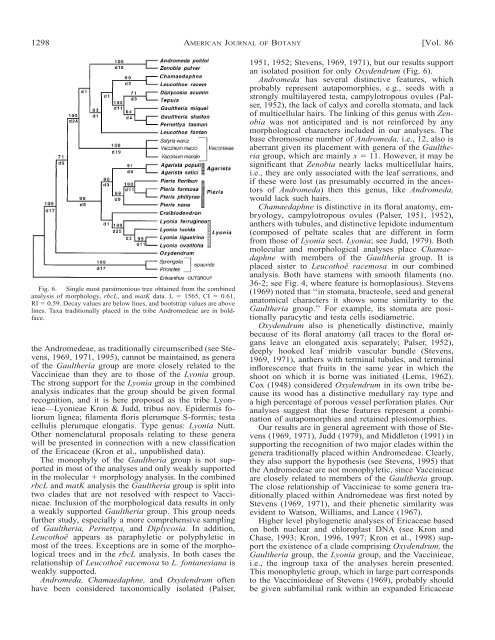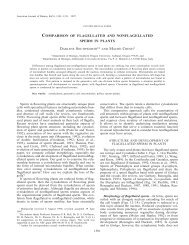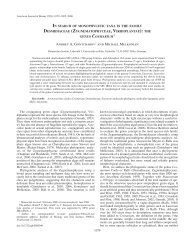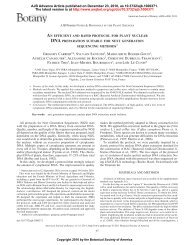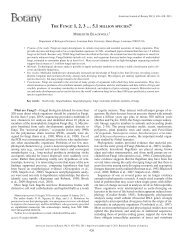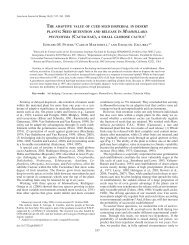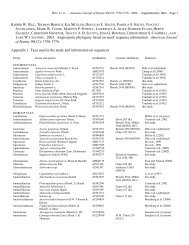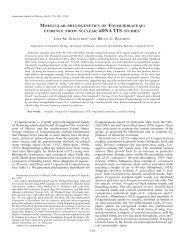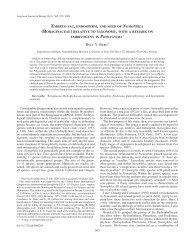View - American Journal of Botany
View - American Journal of Botany
View - American Journal of Botany
Create successful ePaper yourself
Turn your PDF publications into a flip-book with our unique Google optimized e-Paper software.
1298 AMERICAN JOURNAL OF BOTANY<br />
[Vol. 86<br />
Fig. 6. Single most parsimonious tree obtained from the combined<br />
analysis <strong>of</strong> morphology, rbcL, and matK data. L 1565, CI 0.61,<br />
RI 0.59. Decay values are below lines, and bootstrap values are above<br />
lines. Taxa traditionally placed in the tribe Andromedeae are in boldface.<br />
the Andromedeae, as traditionally circumscribed (see Stevens,<br />
1969, 1971, 1995), cannot be maintained, as genera<br />
<strong>of</strong> the Gaultheria group are more closely related to the<br />
Vaccinieae than they are to those <strong>of</strong> the Lyonia group.<br />
The strong support for the Lyonia group in the combined<br />
analysis indicates that the group should be given formal<br />
recognition, and it is here proposed as the tribe Lyonieae—Lyonieae<br />
Kron & Judd, tribus nov. Epidermis foliorum<br />
lignea; filamenta floris plerumque S-formis; testa<br />
cellulis plerumque elongatis. Type genus: Lyonia Nutt.<br />
Other nomenclatural proposals relating to these genera<br />
will be presented in connection with a new classification<br />
<strong>of</strong> the Ericaceae (Kron et al., unpublished data).<br />
The monophyly <strong>of</strong> the Gaultheria group is not supported<br />
in most <strong>of</strong> the analyses and only weakly supported<br />
in the molecular morphology analysis. In the combined<br />
rbcL and matK analysis the Gaultheria group is split into<br />
two clades that are not resolved with respect to Vaccinieae.<br />
Inclusion <strong>of</strong> the morphological data results in only<br />
a weakly supported Gaultheria group. This group needs<br />
further study, especially a more comprehensive sampling<br />
<strong>of</strong> Gaultheria, Pernettya, and Diplycosia. In addition,<br />
Leucothoë appears as paraphyletic or polyphyletic in<br />
most <strong>of</strong> the trees. Exceptions are in some <strong>of</strong> the morphological<br />
trees and in the rbcL analysis. In both cases the<br />
relationship <strong>of</strong> Leucothoë racemosa to L. fontanesiana is<br />
weakly supported.<br />
Andromeda, Chamaedaphne, and Oxydendrum <strong>of</strong>ten<br />
have been considered taxonomically isolated (Palser,<br />
1951, 1952; Stevens, 1969, 1971), but our results support<br />
an isolated position for only Oxydendrum (Fig. 6).<br />
Andromeda has several distinctive features, which<br />
probably represent autapomorphies, e.g., seeds with a<br />
strongly multilayered testa, campylotropous ovules (Palser,<br />
1952), the lack <strong>of</strong> calyx and corolla stomata, and lack<br />
<strong>of</strong> multicellular hairs. The linking <strong>of</strong> this genus with Zenobia<br />
was not anticipated and is not reinforced by any<br />
morphological characters included in our analyses. The<br />
base chromosome number <strong>of</strong> Andromeda, i.e., 12, also is<br />
aberrant given its placement with genera <strong>of</strong> the Gaultheria<br />
group, which are mainly x 11. However, it may be<br />
significant that Zenobia nearly lacks multicellular hairs,<br />
i.e., they are only associated with the leaf serrations, and<br />
if these were lost (as presumably occurred in the ancestors<br />
<strong>of</strong> Andromeda) then this genus, like Andromeda,<br />
would lack such hairs.<br />
Chamaedaphne is distinctive in its floral anatomy, embryology,<br />
campylotropous ovules (Palser, 1951, 1952),<br />
anthers with tubules, and distinctive lepidote indumentum<br />
(composed <strong>of</strong> peltate scales that are different in form<br />
from those <strong>of</strong> Lyonia sect. Lyonia; see Judd, 1979). Both<br />
molecular and morphological analyses place Chamaedaphne<br />
with members <strong>of</strong> the Gaultheria group. It is<br />
placed sister to Leucothoë racemosa in our combined<br />
analysis. Both have stamens with smooth filaments (no.<br />
36-2; see Fig. 4, where feature is homoplasious). Stevens<br />
(1969) noted that ‘‘in stomata, bracteole, seed and general<br />
anatomical characters it shows some similarity to the<br />
Gaultheria group.’’ For example, its stomata are positionally<br />
paracytic and testa cells isodiametric.<br />
Oxydendrum also is phenetically distinctive, mainly<br />
because <strong>of</strong> its floral anatomy (all traces to the floral organs<br />
leave an elongated axis separately; Palser, 1952),<br />
deeply hooked leaf midrib vascular bundle (Stevens,<br />
1969, 1971), anthers with terminal tubules, and terminal<br />
inflorescence that fruits in the same year in which the<br />
shoot on which it is borne was initiated (Lems, 1962).<br />
Cox (1948) considered Oxydendrum in its own tribe because<br />
its wood has a distinctive medullary ray type and<br />
a high percentage <strong>of</strong> porous vessel perforation plates. Our<br />
analyses suggest that these features represent a combination<br />
<strong>of</strong> autapomorphies and retained plesiomorphies.<br />
Our results are in general agreement with those <strong>of</strong> Stevens<br />
(1969, 1971), Judd (1979), and Middleton (1991) in<br />
supporting the recognition <strong>of</strong> two major clades within the<br />
genera traditionally placed within Andromedeae. Clearly,<br />
they also support the hypothesis (see Stevens, 1995) that<br />
the Andromedeae are not monophyletic, since Vaccinieae<br />
are closely related to members <strong>of</strong> the Gaultheria group.<br />
The close relationship <strong>of</strong> Vaccinieae to some genera traditionally<br />
placed within Andromedeae was first noted by<br />
Stevens (1969, 1971), and their phenetic similarity was<br />
evident to Watson, Williams, and Lance (1967).<br />
Higher level phylogenetic analyses <strong>of</strong> Ericaceae based<br />
on both nuclear and chloroplast DNA (see Kron and<br />
Chase, 1993; Kron, 1996, 1997; Kron et al., 1998) support<br />
the existence <strong>of</strong> a clade comprising Oxydendrum, the<br />
Gaultheria group, the Lyonia group, and the Vaccinieae,<br />
i.e., the ingroup taxa <strong>of</strong> the analyses herein presented.<br />
This monophyletic group, which in large part corresponds<br />
to the Vaccinioideae <strong>of</strong> Stevens (1969), probably should<br />
be given subfamilial rank within an expanded Ericaceae


